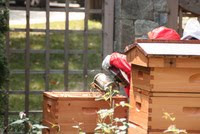On August 25, I arrived in Beijing to spend my junior year doing a study abroad program in Beijing called SYA. I am hoping to learn more about the many environmental problems facing China—especially the disappearance of pollinators. Bees have disappeared altogether in some agricultural regions of China, necessitating hand pollination.
Already I have experienced first hand the pollution problem facing China with the unbelievable smog. I have also seen solutions being tested in the rural areas around Beijing. There are minimum impact areas where the streetlights are even solar powered. This Sunday I am participating in an event for 10-10-10 where we will be racing to collect as much trash as possible in parks around the city. Greening the Beige and 360, two active environmental networks in Beijing, are sponsoring this project. (
http://www.greeningthebeige.org;
http://www.350.org)
I’ve also seen beehives! When hiking a remote area of the great wall, we came across 3 beehives in the village. I was able to speak to one of the beekeepers, which was very interesting. Apparently beehives in China have a lower per-hive output of honey, and the flavor isn’t as good. But the system seemed similar from what I understood, and I was so happy to see honeybees buzzing in the sunshine.
On another note, the probable source of colony collapse has been discovered. A team of scientist has pinpointed a combination of a fungus and a virus that is present in every colony with CCD. However, the reason for the foothold this combination has been able to gain in emptying hives is still the many stresses bees face from pesticides, nutritional deficits in feeding, introduced maladies/pests, etc.
http://www.nytimes.com/2010/10/07/science/07bees.html?_r=2





























